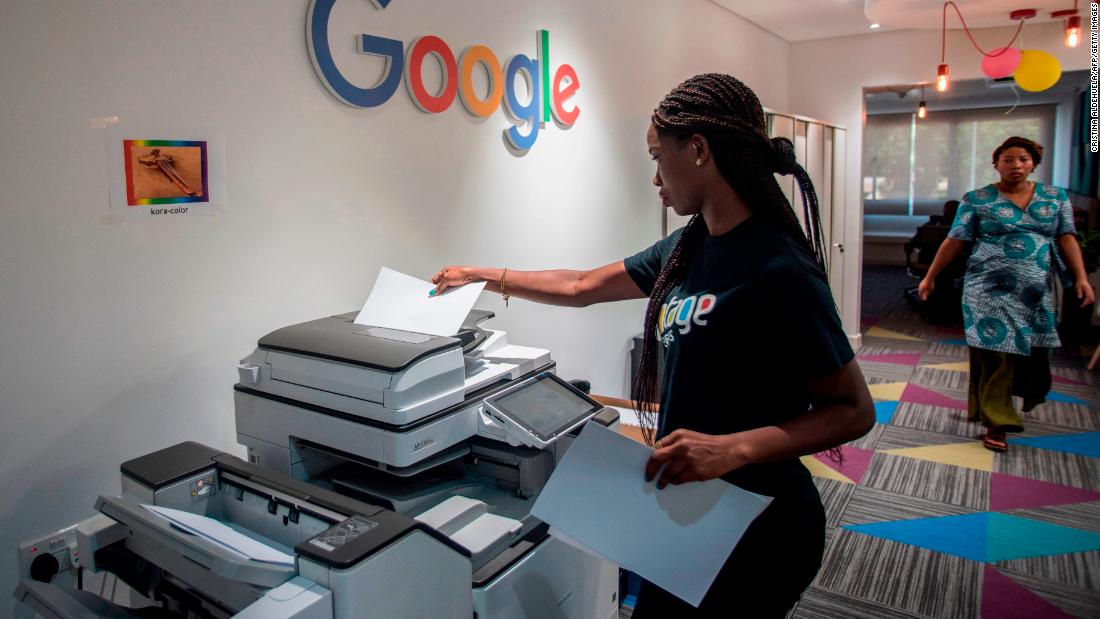During the pandemic in 2020, nearly
20 million more Africans subscribed to a mobile service than in the previous year, according to industry trade group Global System for Mobile Communications (GSMA), with 4G connections
set to double over the next four years.
Tech giants such as Google — which expects hundreds of millions more people to come online across the continent for the first time in the next few years — are moving quickly in the race for Africa’s digital inclusion.
Last year, Google’s joint report with the World Bank’s International Finance Corporation forecasted Africa’s “e-conomy” value would reach
$180 billion by 2025.
This has arguably fueled the company’s commitment of a $1 billion investment in Africa, announced
last month — focusing on grants for businesses, supporting entrepreneurship and a significant infrastructure plan to broaden internet access across the continent.
After the announcement, CNN’s Larry Madowo spoke to Nitin Gajria, Google’s managing director for sub-Saharan Africa, about the company’s plan to improve internet connectivity in Africa and support the continent’s digital transformation.
The following interview was edited and condensed for clarity.
Larry Madowo: Google has made a big deal of investing in the digital landscape in Africa. What regions or specific sectors are you most excited about investing in?
Nitin Gajria: We were thrilled to have announced our $1 billion commitment over the next five years on the continent. These are really mainly in three areas: first, our initiatives related to connectivity, and how do we bring the power of the internet into more hands. The second part of it is how do we help entrepreneurs and small businesses succeed with the internet. And the third part of this commitment is a renewal of our non-profit partnerships on the continent.
We’ve just announced a $50 million Africa investment fund aimed at the growth state startups. That’s one of the things I’m really excited about, our initiatives related to the startup ecosystem on the continent.
LM: How is Google approaching some of the infrastructure challenges that are famous on the continent and the opportunities to build from the ground up?
NG: A few years ago, we would’ve been sitting here talking about how network coverage is a massive challenge. And I think that some of those challenges are being solved. The thing that I think about is the number of internet users that we’re going to have on the continent in the next three to five years. And how do we have the capacity to serve those users in an effective fashion with the right kind of speeds, with the right kind of bandwidth and so on.
And one of the things is “
Equiano,” a subsea cable that we are building along the west coast of Africa which links Europe to Africa. We’ve already announced landing points in Nigeria, in Namibia and in South Africa. This type of capacity that Equiano is going to bring in will have a profound effect on internet speeds, on data costs and just the overall internet experience in the places that impacts.
LM: Can you talk about the role of smartphones in making sure that this is a mobile-first continent and how Google approaches that?
NG: When you look at the profile of new internet users, they tend to use the internet for very different purposes than the first billion people that got onto the internet. As an example, one really profound and interesting shift is somebody that’s never used a keyboard on a laptop or a computer ever before, and for them to encounter a QWERTY keyboard that you normally have in your phone is a really strange experience; which then sort of raises really interesting questions about how do we create an internet that one can interact with through voice or products that can work in local languages. These are the kinds of challenges that I think we need to be very aware of as the next billion people get online.
LM: We like to say in Africa that we’re not a monolith. Talk about what talent you see coming out of the continent versus the rest of the world.
NG: We know that there are going to be more young people in Africa for the foreseeable future than anywhere else in the world. And that just means that you have a base of talent that can go on to build amazing things in Africa. We also see a small but growing and thriving developer population. I do believe that developers are an essential ingredient in any vibrant internet ecosystem. We do see an opportunity and some headroom in terms of growth for developer talent.
LM: As the guy running Google in sub-Saharan Africa, what keeps you up at night?
NG: One is connectivity. Some of the most profound challenges yet the most exciting opportunities on the continent is we have 1.1 billion people in sub-Saharan Africa, (but) only about 300 million people are using the internet in any way, shape or form. So, there’s about 800 million people that have never experienced the power of the internet — how do we bridge that gap? We expect 300 million people to come online over the next five years and after that we expect a lot more.
I’m really excited about the work that various players in the ecosystem are doing. And that’s just talking about the subsea cables that are being built to serve Africa. But there’s also a ton of work being done inland from an infrastructure perspective, whether it’s by the Telco’s or other infrastructure providers and all of this collectively will hopefully go on to solve some of the connectivity challenges that we have on the continent.
CNN’s Gertrude Kitongo contributed to this story.
